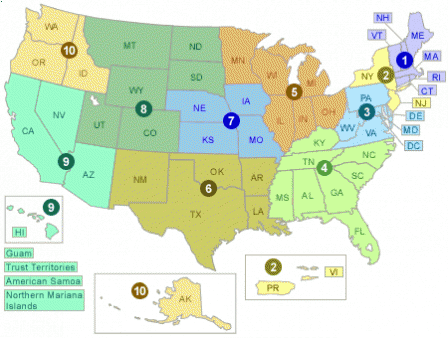Identification of Non-Hazardous Secondary Materials That Are Solid Waste
The non-hazardous secondary material (NHSM) regulations under the Resource Conservation and Recovery Act (RCRA) identify which NHSM are, or are not, solid wastes when burned in combustion units as ingredients or fuels. These regulations help combustion facilities in determining applicable emission standards for combustion units under the Clean Air Act for the purposes of determining which Clean Air Act requirements apply:
- Units that burn NHSM that are not solid waste under RCRA are subject to the section 112 Clean Air Act (CAA) requirements.
- Units that burn NHSM that are solid waste under RCRA are subject to the section 129 CAA requirements.
Non-hazardous secondary materials are any materials that are not the primary product of a manufacturing or commercial process, and can include post-consumer material, post-industrial material, and scrap. Many types of these materials have British Thermal Unit (BTU) or material value, and can be reclaimed or reused in industrial processes. A wide and diverse range of NHSMs exists and some percentage of the approximately 200,000 boilers or industrial furnaces use these secondary materials as substitutes for primary fuels or as ingredients.
On this page:
- NHSM Rulemakings
- NHSM Regional Petitions Under 40 CFR Section 241.3(c)
- Implementation of the NHSM Regulations
- EPA Regional Contacts for the NHSM Waste Determination
NHSM Rulemakings
On March 21, 2011, EPA promulgated the base NHSM regulations titled “Identification of Non-Hazardous Secondary Materials that are Solid Waste” establishing 40 CFR part 241. The March 2011, NHSM final rule provides the standards and procedures for identifying whether NHSMs are solid waste under the RCRA when used as fuels or ingredients in combustion units. Subsequent rulemaking efforts have expanded and clarified the 40 CFR part 241 regulations.
- November 1, 2016 - Proposed Rule on Additions to List of Categorical non-Waste Fuels: Other Treated Railroad Ties
- February 8, 2016 - Final Rule: Additions to List of Categorical Non-Waste Fuels and April 14, 2014 Proposed Rule
- February 7, 2013 - Final Rule (Revisions) and December 23, 2011 Proposed Revisions
- March 21, 2011 - Final Rule and June 4, 2010 Proposed Rule
- January 2, 2009 - Advanced Notice of Proposed Rulemaking (outlined a framework for the subsequent proposal and final rule)
NHSM Regional Petitions Under 40 CFR Section 241.3(c)
The documents below provide information on EPA's final decision granting a July 1, 2013 application submitted by FibroMinn, LLC (currently known as Benson Power, LLC) to Region 5 for a non-waste determination under the NHSM rule provision at 40 CFR 241.3(c). This decision applies to poultry litter burned as fuel in the boilers at the Benson, Minn. power plant to produce electricity.
- Final Decision Granting an Application for a Non-waste Determination Determination Regarding Benson Power, LLC Poultry Litter
- Technical Review Document on FibroMinn's Petition for a Non-Waste Determination Pursuant to 40 CFR 241.3(c)
Implementation of the NHSM Regulations
Contaminant Comparisons
The tables present summary statistics for contaminant concentrations in common traditional fuels. The data listed in the tables may be useful when comparing contaminants in the NHSMs to contaminants in the appropriate traditional fuels. (Note: per the legitimacy criteria in 241.3(d))
Part 241 Rule Clarifications and Response Letters
The response and clarification letters are examples of EPA determinations regarding 40 CFR part 241 based on the information provided. They are included in the Agency's RCRA Online database for informational purposes only. EPA does not endorse or promote any particular product, service or entity.
EPA Regional Contacts for the NHSM Waste Determination
| Region | Contact Information |
|---|---|
| 1 (CT, ME, MA, NH, RI, VT) | Elizabeth McCarthy 617-918-1447 Mccarthy.Liz@epa.gov |
| 2 (NJ, NY, Puerto Rico, the Virgin Islands) | Joseph Malki (212) 637-4101 Malki.Joseph@epa.gov |
| 3 (DE, MD, PA, VA, WV, District of Columbia) | Cassie McGoldrick 215-814-3399 McGoldrick.Catherine@epa.gov |
| 4 (AL, FL, GA, KY, MS, NC, SC, TN) | David Langston (404) 562‐8478 Langston.David@epa.gov |
| 5 (IL, IN, MI, MN, OH, WI) | Carol Staniec (312) 886-1436 Staniec.Carol@epa.gov |
| 6 (AR, LA, NM, OK, TX) | Golam Mustafa Mustafa.Golam@epa.gov 214-665-6576 |
| 7 (IA, KS, MO, NE) | Ken Herstowski herstowski.ken@epa.gov 913-551-7631 |
| 8 (CO, MT, ND, SD, UT, WY) | Brenda South (303) 312-6446 south.brenda@epa.gov |
| 9 (AZ, CA, HI, NV) | Steve Wall (415) 972-3381 Wall.Steve@epa.gov |
| 10 (AK, ID, OR, WA) | Lisa McArthur Mcarthur.Lisa@epa.gov 206-553-1814 |
